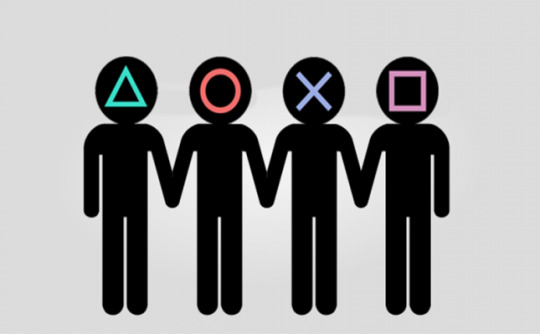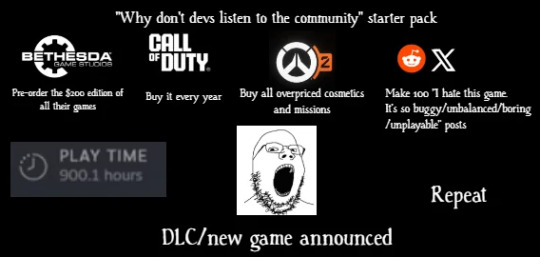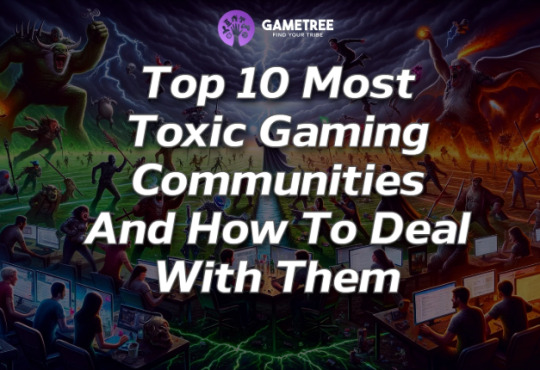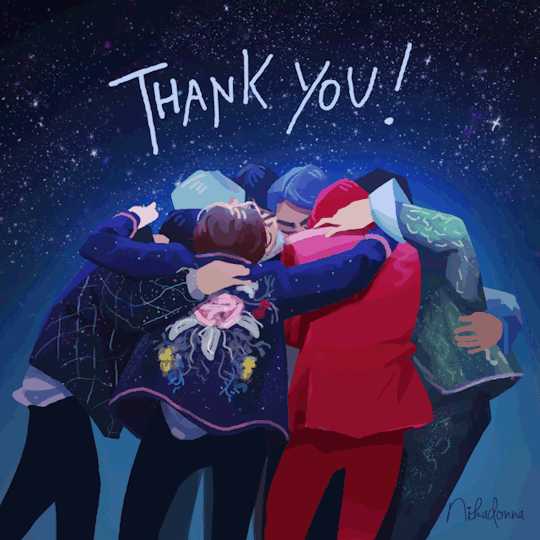Don't wanna be here? Send us removal request.
Text
Social Gaming And Its Importance
In today’s digital age, gaming has evolved far beyond a solitary activity into a shared experience that connects people across the globe. Social gaming, which integrates the pastime of gaming and socializing into a whole, has become a driving force in the gaming industry. Whether it be collaborative gameplay, friendly competition, or online communities, social gaming is reshaping how people connect, especially introverts. But its influence is not only limited to just fun and games, it has become a powerful tool in building relationships, fostering teamwork, and influencing societal trends. In this week’s blog post, I will be covering social gaming and its importance.

Before continuing, it is crucial we understand what social gaming means. Social gaming according to Rehj (N/D), incorporates aspects of social interaction, allowing players to communicate with others in real time, share their gaming stories, and even build communities within the gaming world. Logan (N/D) notes that social gaming is often used for brief moments of relaxation and distraction, and games like these should offer easy and repetitive tasks, tutorials, opportunities for social interaction, the ability to resume gameplay without hassle, and visibility of other players’ actions. Social gaming possesses the ability to bring people together and foster connection amongst gamers.

Undoubtedly, social gaming has given birth to a wide range of gaming communities. Gaming communities bring players from around the world with a similar goal together. As BG Games (2023) writes, the virtual environments of games dissolve boundaries and offer unique opportunities for interaction. Think of it as ice-breaking, but the ice is way thinner than usual. Certain times, these online interactions can even lead to unbreakable bonds and formidable friendships. In Wilson’s (2024) article, he explains that for gamers and fans, Discord is not just another communication tool, it is a vibrant platform for building friendship, collaborating, and sharing experiences. With the array of different channels for communication, users can maintain in-game connections, host discussions, celebrate achievements, and even support one another through life’s challenges (Wilson A. 2024).

Other than just fostering relationships between gamers, gaming communities are important to game developers. Through forums and social media platforms, developers receive direct input from players, and oftentimes, these communities offer valuable insights and suggestions that enhance gaming experience (BG Games, 2023). According to Andersen G., & the MoldStud Research Team (2024), working with players guarantees that games are created and structured with the players in mind, which can lead to games tailored to specific experiences. Gamers are often filled with and generate interesting ideas and stories. Collaborating with them not only encourages a sense of ownership but also improves the overall quality of the game.

However, social gaming is not without its complexities. The rise of social gaming and the continued growth of gaming communities has given rise to a persistent issue. Which is toxicity in gaming communities. American SPCC (2024) notes that toxic behavior can be observed as harassment, hate speech, bullying, and disorderly behavior, adversely affecting players’ experiences and mental health. Due to the anonymous nature of digital platforms, players are more inclined to engage in harmful or rebellious behavior, feeling less accountable for their actions and more emboldened to act aggressively. The American SPCC (2024) mentions that anonymity creates a separation between actions and responsibility, leading to an environment where players can harass, use offensive language, or behave maliciously without facing immediate consequences.

Furthermore, games that are competitive require unrelenting concentration and usually evoke strong emotions such as anger and frustration. Hence, losing in these types of games can lead to arguments and conflicts. In certain gaming communities, toxic behavior has become normalized or even encouraged. This is particularly common in games where “trash talk” is seen as a core part of the gaming experience (American SPCC 2024). As a result, newcomers may be deterred and never visit the game related to the community again.
In conclusion, social gaming has revolutionized the way gamers connect, offering a platform for building friendships, collaboration, and even sharing experiences. Its inherent ability to bridge gaps between players, especially those that are more introverted, has created safe spaces where relationships can thrive. However, as with any dynamic environment, it presents its own set of challenges, with toxicity and disorderly behavior being the main issues. While certain gaming platforms like Discord offer an environment for people to come together, the anonymity that comes with it can sometimes fuel a negative agenda. It is important that we note the benefits that come with social gaming as well as its downsides moving forward. With vigilance, awareness of the feelings of others, and ample education of professionalism, we can ensure that a safer environment is created for all gamers, guaranteeing that social gaming continues to be a safe space where connections are strengthened and fun is prioritized.

------------------------------------------------------------------------------
References:
American SPCC, 19 September 2024, The Problem of Toxicity In gaming Communities And Ways To Overcome It, AmericanSPCC, viewed 20th November 2024, https://americanspcc.org/the-problem-of-toxicity-in-gaming-communities-and-ways-to-overcome-it/#:~:text=However%2C%20the%20rise%20of%20online,experiences%20and%20mental%20well%2Dbeing.
Andersen G. & MoldStud Research Team, 24th January 2024, Game Developers and Player Communities: Building Engagement, MoldStud, viewed 20th November2 2024, https://moldstud.com/articles/p-game-developers-and-player-communities-building-engagement
BG Games, 16th August 2023, Gaming Communities: The Rise and Impact of Gaming Communities on the World of Video Games, Medium, viewed 20th November 2024, https://bggames.medium.com/gaming-communities-the-rise-and-impact-of-gaming-communities-on-the-world-of-video-games-1fec152f649f
Logan B., N/D, Social Gaming: A Usability Perspective, Spotless, viewed 20th November 2024, https://www.spotless.co.uk/journal/social-gaming-usability
Rehj, N/D, Social Gaming Unleashed: Understanding Its Concept, Benefits, and Leading Platforms, AOK Marketing, viewed 20th November 2024, https://aokmarketing.com/social-gaming-unleashed-understanding-its-concept-benefits-and-leading-platforms/
Wilson A., 5th November 2024, How to build safe and social gaming communities, Levellr, viewed 20th November 2024, https://www.levellr.com/blog/how-to-build-safe-and-social-gaming-communities
0 notes
Text
Fans or Fanatics?
We all have expressed our admiration for a celebrity at least once in our entire lives. Be it towards a famous music artist, actor, author or sports athlete, humans are not shy when it comes to showing our passion towards the talent of others. Fandom, as its name suggests, is a community made up of fans that show the same interests in a certain topic. A.R.M.Y, a fandom of the popular K-pop group BTS, is an example of a fandom that is heavily devoted to defending their favorite boy band. They come together to support the group’s success, defend any attempts to scrutinize them as well as celebrate their idols’ achievements. Fandoms are basically 'hubs' of superfans.

According to Later (N.D), a “fandom” refers to a community of fans who are deeply passionate about a specific form of entertainment, like a TV show, movie series, book, video game, or music group. On social media however, “fandom” describes a group of fans who bond over a shared enthusiasm for a specific person, franchise, celebrity, TV show, movie, book, or other forms of entertainment. More specifically, the word “fan” in “fandom” is derived from the word “fanatic”, which usually carries a somewhat negative meaning (Iyengar V., 2022). The word was initially used to refer to people who were passionate about sports, however, the term slowly changed its meaning and came to describe people with an unrelenting interest towards pop culture-related topics.

The formation of fandoms can be attributed to humans and history. We as a species have evolved to thrive in groups, seeking a sense of community and identity with others. According to Team MindPeers (2023), the idols we look up to, the stories that connect with us, and the collective people of fandoms we share experiences with all play a role in shaping our personal narratives and, ultimately, our identity. Other than just connecting with others, fandoms allow us a break from reality and the routine of everyday life (Team MindPeers, 2023).

The significance of fandoms in today’s society is immense, and it begs the question, who is more prone to join a fandom? Temming M., (2022) notes that people with empathy are more inclined to fall in love with fictional worlds or become a superfan. Empathy allows them to connect emotionally to the fictional characters, topics, or celebrities more often than others and these people tend to put themselves in the situations of others. Another characteristic of fans that determines their likelihood of joining fandoms is how easily they connect with the story (Temming M., 2022). The immersion of a fictional story can change the perspective of an individual and can in turn, foster a fandom.
An aspect of fandoms that people usually shrug off is the ability for fandoms to carry out acts of solidarity, support, and sometimes, even activism. “Directioners”, fans of the popular English boy band One Direction, helped raise 2 million pounds for Red Nose Day, and this paired with various other fundraising efforts by the fandom lead to the creation of “Action/1D”, One Direction’s very own charity (Lavelle B., 2024). It’s not just music fandoms that have used their power for good of people, other fandoms such as the anime and manga fandoms have their writers participate in events as well. These writers will create custom work based on the good acts of charity to Palestinians by fans (Lavelle B., 2024).

However, more people means more opinions, and in big fandoms where the number of people is vast, there is bound to be high volatility and many disagreements. Some fandoms may even come together to spread their dissatisfaction on someone or something, and this act of hate can lead to disastrous consequences. The term used to describe this phenomenon is “toxic fandom”, a dark side of fandom that the majority of people generally associate with fans. Most of these negative acts are carried out online in websites or forums such as Twitter and Reddit, although they can also be observed in physical meetings or conventions (Vinney C., 2023). An infamous example of toxic fandoms carrying out their repulsive acts is in 2016 when a segment of the “Ghostbusters” fandom opposed the reboot of the original movie and directed racist and misogynistic tweets at star Leslie Jones (Vinney C., 2023).

All in all, fandoms, while often celebrated for their passion and dedication towards their shared interests, are complex communities that can bring good and harm to others. The sense of identity and belonging that these communities provide further notes their importance in our society. Ultimately, the power of fandoms lies in the hands of those who are in it. As fandoms around the world continue to evolve, it is essential that we acknowledge its capacity for both good and bad, and that we can approach it with an open-minded perspective.
------------------------------------------------------------------------------
References:
Fandom, Later, viewed 13th November 2024, https://later.com/social-media-glossary/fandom/
Iyengar V., 18th July 2022, What Is the Psychology of Celebrity Fandoms?, Psych Et Al, viewed 13th November 2024, https://www.psychetal.com/post/what-is-the-psychology-of-celebrity-fandoms
Lavelle B., 18th September 2024, How fandoms create communities and support larger causes, IndigenousX, viewed 13th November 2024, https://indigenousx.com.au/how-fandoms-create-communities-and-support-larger-causes/
Team MindPeers, 3rd August 2023, Behind The Screens: Unraveling the Psychology Behind Fandoms, MindPeers, viewed 13th November 2024, https://blog.mindpeers.co/behind-the-screens-unraveling-the-psychology-behind-fandoms
Temming M., 10th November 2022, Why fandom feels good – and may be good for you, ScienceNewExplores, viewed 13th November 2024, https://www.snexplores.org/article/fandom-fan-psychology-comiccon-marvel-fiction
Vinney C., 28th November 2023, What Are Toxic Fandoms?, VeryWellMind, viewed 13th November 2024, https://www.verywellmind.com/what-is-toxic-fandom-5214499
3 notes
·
View notes
Text
Social Media As A Crowdsourcing Tool
The Internet has evolved drastically throughout the years since its initial release in the late 20th century. From allowing governments to share research resources to connecting people worldwide via social media, the Internet is without doubt an integral part of today’s society. There are a multitude of uses for the Internet and I would like to focus on the Internet as a crowdsourcing tool in this week’s blog.

Hargrave M. (2024) defines crowdsourcing as involving the gathering of work, information, or opinions from a vast number of individuals who share their data through the Internet, social media platforms, and mobile apps. However, the term was first coined in 2006 by Wiredmagazine author Jeff Howe in his article titled “The Rise of Crowdsourcing” and is a portmanteau of the words “crowd” and “sourcing”. Some advantages of crowdsourcing include reducing costs, speed, and tapping into skills not present in an in-house team (Hargrave M., 2024). Lloyd C.’s (2024) article notes that crowdsourcing has emerged as a powerful method for sparking innovation by tapping into the combined knowledge and creativity of a wide global group of contributors.

Certain uses of crowdsourcing include using user data to improve current applications or websites, gaining customer insight and preferences, crowdfunding, and problem solving and idea generation. The Mainstreethost Team (2024) mentions that Waze, a famous GPS navigation app, demonstrates crowdsourcing by using user data to give users the necessary information for a safe journey to their destination. Waze is not shy about showing people that their success is attributed to the contribution and support of their global userbase and this is evident on their website where they state “In 2009, we created a crowd-sourced navigation app that would make it easier to circumvent literal and figurative bumps in the road. How? By working together.” (The Mainstreethost Team, 2024). Unilever, a fast-moving consumer goods company, created the Foundry platform to engage with startups and innovators globally, aiming to find solutions for their business challenges. The platform invited participants to submit their ideas across various areas, such as product development, marketing, and sustainability initiatives (Lloyd C., 2024).
Additionally, crowdsourcing can be observed in ways other than the aforementioned. People can take to the Internet or social media to share news of current world events such as the infamous Notre-Dame Cathedral fire, where an inferno engulfed the spire of the building and most of its roof. Consumers now do not have to solely rely on news outlets to gain insight into new content. They can interact with journalists, news organizations as well as fellow readers directly, giving feedback and sharing their opinions and insights at the same time (Yellowbrick, 2023). The sharing of news can be seen as crowdsourcing as people are splitting the workload of news outlets through the Internet.

Crowdfunding is also an example of crowdsourcing. Smith T. (2024) defines crowdfunding as involving the gathering of money or funding of a business by collecting small amounts of capital from a large group of individuals. Smith T. (2024) mentions the importance of raising capital for the growth of a company and that established organizations and companies usually face no challenge in borrowing extra capital. However, small startups often come across obstacles in this area and this is exactly where crowdfunding comes in. Usually, small startups would take onto the Internet to post adverts of their company and state that they need funding. They would then include links to various fund donation websites such as GoFundMe in their adverts or social media posts and hope that users would stumble upon their announcement. These posts usually have a goal amount set for the donators to achieve, such as 100,000 US dollars or more.

The effectiveness of crowdfunding can be improved using social media. Castellano P. writes that demonstrating social proof using your social media profiles can increase the legitimacy of your business and people are more inclined to support your company when they see others doing the same. Another method of improving your company’s crowdfunding, as indicated in Castellano’s writing is promoting giveaways in your social media accounts or platforms. Doing so will increase your business’ popularity as well as reach, which in turn can lead to increased audience engagement.
To conclude, I personally think that the Internet or social media, to be exact, can be an effective tool for crowdsourcing if used strategically. Its unparalleled potential from improving products to funding new ventures and sharing crucial information transforms how we collaborate and create. The ability for people to come together to achieve a goal in unison creates a sense of shared purpose that drives meaningful progress in today’s digital world.
------------------------------------------------------------------------------
References:
Castellano P., The Role of Social Media in Crowdfunding Success, Funded Today, viewed 6th November 2024, https://www.funded.today/blog/the-role-of-social-media-in-crowdfunding-succcess#:~:text=Social%20media%20is%20an%20important,buzz%20and%20attract%20new%20backers
Hargrave M., 17th October 2024, Crowdsourcing: Definition, How It Works, Types, and Examples, Investopedia, viewed 6th November 2024, https://www.investopedia.com/terms/c/crowdsourcing.asp#:~:text=Crowdsourcing%20is%20the%20collection%20of,from%20all%20over%20the%20world.
Lloyd C., 18th July 2024, 5 Crowdsourcing Examples that Delivered Impressive Business Results, Qmarkets, viewed 6th November 2024, https://www.qmarkets.net/resources/article/five-crowdsourcing-examples/
The Mainstreethost Team, 9th September 2024, 4 Examples of Clever Crowdsourcing Campaigns, Mainstreethost, viewed 6th November 2024, https://www.mainstreethost.com/blog/four-examples-of-clever-crowdsourcing-campaigns/
Smith T., 30th May 2024, Crowdfunding: What It Is, How It Works, and Popular Websites, Investopedia, viewed 6th November 2024, https://www.investopedia.com/terms/c/crowdfunding.asp
Yellowbrick, 4th December 2023, The Power of Social Media in News Spreading, Yellowbrick, viewed 6th November 2024, https://www.yellowbrick.co/blog/journalism/the-power-of-social-media-in-news-spreading
1 note
·
View note
Text
Can Social Media Be Used To Spread Health Awareness?
In 2024, it can be said that everyone is familiar with the words “social media”, a term synchronous with dopamine-seeking Internet users that scroll endlessly on their phones all day with their eyes glued to an LED screen. Though this may seem worrisome, which it is, social media has several upsides to it that make the aforementioned issue seem justifiable.

Specifically, social media can be used to spread health awareness to its users. The infamous Ice Bucket challenge in 2014 was started to promote awareness of the amyotrophic lateral sclerosis disease and also showcases the unmatched potential social media wields when it comes to educating the public on urgent issues currently plaguing in the world.

Mohammed W. et. al. (2021) said that social media holds significant potential for sharing information about healthy behaviors, disease prevention, treatment, management, and care.

Additionally, health educators have leveraged social media to establish support groups, advocate for health equity among disadvantaged communities, engage with partners, and dispel misinformation on public health issues. As technology advances and social media evolves, it is becoming a powerful tool for raising awareness, educating on socially relevant topics, and conducting activities, online courses, and classes more efficiently than traditional face-to-face interactions (Latha K. et. al, 2020). Latha K. et. al. (2020) continues in their report saying that social media facilitates the connection of people, leading to increased exchange of information regarding health.
Continuing from the aforementioned Ice Bucket challenge are other challenges with similar aims of spreading health awareness to social media users. Another example is the No Make-Up Selfie challenge whose main objective was to spread cancer awareness by having women post selfies where they were not wearing make-up. BC NEWS (2014) stated that the trend grew on its own and was not started by cancer charities or organizations. Additionally, we have “Movember”, which is a trend where in every November, men were challenged to grow mustaches and both men and women were urged to be more physically active to raise awareness about men’s mental issues. Movember began in Australia in 2003 to raise awareness about men’s health issues. By 2004, it became an official charity, with all proceeds directed to the Prostate Cancer Foundation of Australia (Manulife Malaysia).

However, social media users should still be wary of any health-related information they come across on the internet or the various applications they use. The spread of health misinformation is rampant in the digital world, and many have already believed its false claims. Chou W. Y. S. et. al. (2020) defines health misinformation as any health-related statement of fact that is inaccurate according to current scientific consensus. Monica L. W. (2024) wrote that vaccines are the leading subject of misleading health information with some myths being infertility after vaccination and supposed cause of autism related to vaccines. Not surprisingly, these hoaxes have led to the demise of many people, as seen in the recent COVID-19 pandemic, there was widespread confusion between people who opposed vaccination and those who supported it. According to the data from Brown University School of Public Health, approximately 319,000 COVID-19 deaths in the United States between January 2021 and April 2022 could have been prevented if those individuals had been vaccinated (Monica L. W., 2024).

The myriad of false information on the internet and social media alike have grown to immeasurable proportions. With at least 80% of online people using the internet for health-related topics, an NBC News analysis has raised concerns about what type of information these people may have run into (Brandy Z., 2019). Brandy (2019) continues in her article writing that cancer is the most common topic of health misinformation, with viral articles advocating unverified cancer cures accounting for one-third of their list.

Having said all this, it seems obvious that the cons far outweigh the pros in this scenario. The damage that health misinformation on the internet has done is severe and long lasting, forcing users to think twice about every article or post they come across that is related to health. However, I still believe that social media can be used to spread health awareness effectively. With the right support, audience, and a solid foundation built through trust and results, individuals and organizations alike can utilize the vast power of social media to bring health education to the masses.
------------------------------------------------------------------------------
References:
Brandy Z., 29th December 2019, Social media hosted a lot of fake health news this year. Here’s what went most viral, NBC News, viewed 24th October 2024, https://www.nbcnews.com/news/us-news/social-media-hosted-lot-fake-health-news-year-here-s-n1107466
Chou W. Y. S., Gaysynsky A., Capella J. N., October 2020, Where We Go From Here: Health Misinformation on Social Media, PubMed Central, viewed 24th October 2024, https://pmc.ncbi.nlm.nih.gov/articles/PMC7532328/
Latha K., Meena K. S., Pravitha M. R., Dasgupta M., Chaturvedi S. K., 28th May 2020, Effective use of social media platforms for promotion of mental health awareness, PubMed Central, viewed 23rd October 2024, https://pmc.ncbi.nlm.nih.gov/articles/PMC7325786/
Manulife Malaysia, Get Ready for Movember because there’s #nothingtofear, Manulife, viewed 23rd October 2024, https://www.manulife.com.my/en/individual/insights/get-ready-for-movember-because-nothing-to-fear.html
Mohammed W., Alanzi T., Alanezi F., Alhodaib H., AlShammari M., 2021, Usage of social media for health awareness purposes among health educators and students in Saudi Arabia, Elsevier, viewed 23rd October 2024, https://www.sciencedirect.com/science/article/pii/S2352914821000435\
Monica L. W., 9th February 2024, POV: Health Misinformation Is Rampant on Social Media, BU Today, viewed 24th October 2024, https://www.bu.edu/articles/2024/health-misinformation-rampant-on-social-media/
Roy R. & Malloy J., 8th May 2023, Evolving Role of Social Media in Health Promotion, Intechopen, viewed 23rd October 2024, https://www.intechopen.com/chapters/87491
BBC NEWS, 22nd March 2014, Why the ‘no make-up selfies’ campaign raised £2m, BBC NEWS, viewed 23rd October 2024, https://www.bbc.com/news/health-26683817
1 note
·
View note
Text
Is blogging still relevant in the age of TikTok and Instagram?
Yes. I think blogging is still relevant in the age of TikTok and Instagram. Blogging is the process of creating articles with photos, texts, and content, then publishing them on various websites on the internet for people to access and read. Blogging is usually characterized by a more laid-back atmosphere, informal writing, and a fixed format for its content.

According to SEO (Jan 2024), at least 60% of internet users read blogs and 77% of internet users read blogs every day. Information in the form of reading is quicker than through speech. Jonathan Andreas (May 2019) says that the average reader can read on average 241 words per minute whereas the average person can only speak about 100-150 words per minute. Needless to say, reading is undoubtedly a quicker method for consuming information.

GIF by muvana
Other than being a faster means of consuming information, blogging can also be used as a form of culture practice, taste making, and community formation, which can lead to the inclusion or exclusion of certain types of people. For example, a blog showcasing Chinese culture may appeal to a specific group of people that appreciates the tradition but may be uninteresting to others. Other examples of this usage of blogs include health blogs, fashion blogs, and political blogs.
According to Emily Shwake (Feb) in the field of business, business blogging can increase the overall pages on your company website, which leads to the growth of the company’s online presence thereby increasing the chances of potential customers stumbling upon you. A study conducted found that businesses that do not blog receive up to 55% less website visitors compared to those that do. Instead of a short few-seconds advertisement, blogs provide potential customers the chance to know more of the company via FAQs or posting important news or updates (Emily Shwake, Feb). Furthermore, as Emily (Feb) suggests that blogging can increase customer engagement. This can lead to repeat business or the increase of potential customers as current ones share blogs or news with people that may have never heard of the company before. Amanda Hetler (Jun 2022) states that blogging also creates content for social media platforms. By just sharing the link to a blogpost once it has been created, information of a business or company can reach more people.

Connecting with other people is one of the major advantages of blogging (Artem Minaev, May 2024). Blogging is where authentic relationships are built and unlikely friends are met. Blogging in a sense serves as a medium for people to communicate and connect based on their goals, similarities, interests. Therefore, blogging can lead to the unintentional sprouting of communities and public spheres on the internet where internet users come to express their feelings and/or opinions. Adding on, Elin (March 2018) states that blogging grants internet users the ability to voice out their opinions, experiences, stories, and reviews.
There is, however, an unexpected application of blogging. That is blogging as a source of income. Eb Gargano (June 2024) states 5 ways to earn money via blogging which are advertising, affiliate links, sponsored posts, products, and services. As blogging is usually done on websites, advertising is an obvious choice if one chooses to earn income while blogging. The more internet browsers that view your ads (ad impressions), the higher your pay (Eb Gargano, June 2024). Blogging can also help improve one’s writing. After all, blogging delves into the realm of conveying one’s opinions, thoughts, and ideas, and all of these aspects have to be written. Alex Tiffany (December 2023) says that the more you write, the better you will write.

On the contrary, there are cons to blogging that may deter internet users from ever becoming a blogger in the first place. According to Kayla (May 2021), bloggers may end up with nothing in return even after investing tons of time and effort into their blogging career. She compares this to undertaking a costly university degree that may not warrant a path of success. Blogging is simply a risk (Kayla, May 2021). Additionally, Kayla (May 2021) states that businesses may end up repelling potential customers if they do not properly blog their business. If blogging for your business does not build or lead to know-like-factor in customers, then it is only adversely impacting the business. Blogging in today’s world is highly competitive. Distinguishing your blog in the gigantic pool of more than 600 million present blogs is no easy task (Alex Tiffany, December 2023).
Even after considering the downsides, there are many benefits to blogging that make me think that it is still relevant in the age of TikTok and Instagram and that it may stand the test of time.
2 notes
·
View notes
Text
Who am I?
Hi, I'm Silas Stephen Ng Ai Peng and I'm currently 22 years old taking Bachelor of Computer Science in Swinburne University of Technology Sarawak.
I'm an avid gamer and I play games quite often, usually Valorant. I play badminton recreationally with my pals on the weekends and I listen to hardstyle music from time to time from artists like Da Tweekaz and Darren Styles.

Disclaimer!
All the posts on this blog will be for educational purposes only!
1 note
·
View note